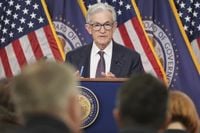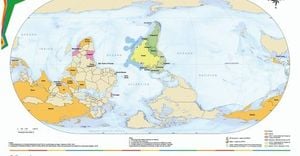The Federal Reserve opted to leave interest rates unchanged on Wednesday, May 7, 2025, citing heightened risks of rising inflation and slowing growth, which have prompted renewed warnings about stagflation. This decision marks the third consecutive meeting at which the Federal Open Market Committee (FOMC) has held rates steady, maintaining the federal funds rate at a target range of 4.25% to 4.5% since December 2024.
In its latest statement, the Fed acknowledged increasing uncertainty in the economic outlook. The statement read, "Uncertainty about the economic outlook has increased further. The Committee is attentive to the risks to both sides of its dual mandate and judges that the risks of higher unemployment and higher inflation have risen." This reflects a significant shift in the Fed's approach as it grapples with the implications of ongoing trade tensions and their impact on the economy.
Federal Reserve Chair Jerome Powell, addressing reporters after the meeting, emphasized that the Fed is closely monitoring the situation, particularly in light of President Donald Trump’s implementation of new tariffs, which have added pressure to the economy. Powell stated, "There's just so much that we don't know, I think, and we're in a good position to wait and see, is the thing. We don't have to be in a hurry. The economy has been resilient. It's doing fairly well. Our policy is well-positioned."
The Fed's decision to keep rates steady comes amid a backdrop of a trade war between the U.S. and China, further complicated by Trump's recent tariffs on Chinese goods. Analysts have noted that these tariffs contribute to a challenging economic environment, with Powell indicating that the risks of higher inflation and unemployment are significant. He remarked that the Fed needs time to evaluate the economic impact of these tariffs.
Market analysts had largely anticipated the Fed's decision, but the updated policy statement raised concerns about stagflation—a scenario characterized by stagnant economic growth coupled with rising inflation. Economists now view stagflation as the baseline scenario for the U.S. economy, aligning with the Fed's own projections of higher inflation and slower growth. This marks a stark contrast to Powell's earlier stance when he dismissed stagflation concerns, famously stating, "I don’t see the stag or the flation."
As the Fed navigates these contradictory economic signals, it faces a policy dilemma. Maintaining high interest rates could help control inflation but might further slow economic growth. Conversely, cutting rates could stimulate the economy but risks accelerating inflation. Analysts suggest that the chance of an interest rate cut at the current meeting was minimal, but the focus will now shift to Powell's press conference, where he will address how the Fed plans to tackle these economic challenges.
Financial markets reacted cautiously to the Fed's announcement, with the S&P 500 closing slightly higher, while the tech-heavy Nasdaq saw a decline. The market is currently pricing in a potential 25 basis-point rate cut in July, although many experts believe this is premature given the current economic uncertainties. The provisional forecast suggests that any rate cut will depend heavily on upcoming economic data that clearly illustrates the impact of trade taxes on the economy.
In addition to the Fed's concerns, the broader economic landscape shows signs of strain. The Bureau of Economic Analysis reported a first-quarter contraction of approximately 0.3%, while inflation pressures have only eased modestly. The Fed's preferred inflation gauge indicated core prices rising at an annual rate of 2.6% in March, significantly above its 2% target.
The job market remains relatively stable, with 177,000 new hires reported last month and an unemployment rate of just 4.2%. However, the Fed's acknowledgment of rising risks to both inflation and unemployment underscores the delicate balance it must strike in its monetary policy.
As the economic situation continues to evolve, the implications of stagflation are significant for both consumers and businesses. Households may find their purchasing power diminished as prices rise faster than wages, while investors could see stock markets falter due to slowing economic output and declining earnings. Businesses, particularly those reliant on imported materials or operating with tight profit margins, may also face challenges.
The next few months will be crucial in determining whether the U.S. economy can avoid falling into a stagflation scenario. As global markets respond to mixed economic signals, the Federal Reserve's decisions and Powell's guidance will play a critical role in shaping the economic landscape ahead. Investors and policymakers alike will be watching closely to see how the Fed navigates these tumultuous waters, especially as Trump continues to press for lower interest rates, labeling Powell a "total stiff" for his reluctance to act swiftly.
In conclusion, the Federal Reserve's recent decision reflects a cautious approach in the face of rising economic uncertainty and the looming threat of stagflation. As the central bank grapples with its dual mandate of maximizing employment and maintaining price stability, the balance it strikes in the coming months will be pivotal for the U.S. economy.




